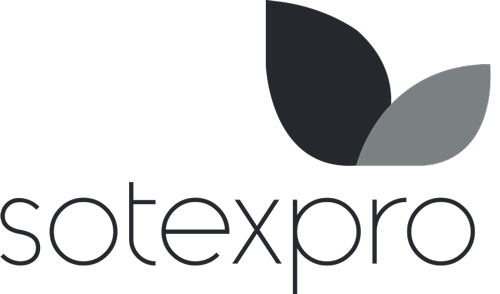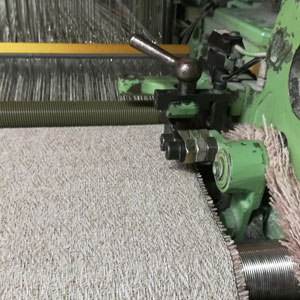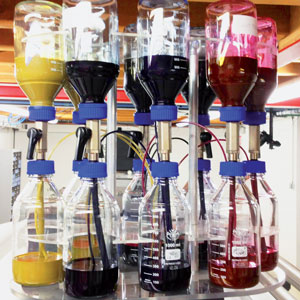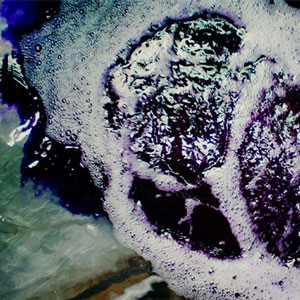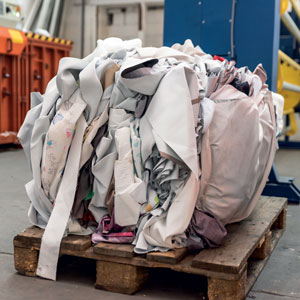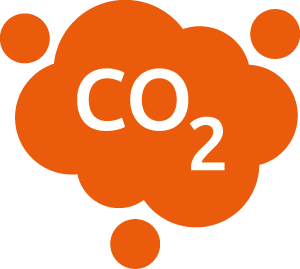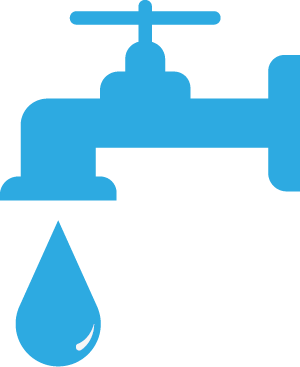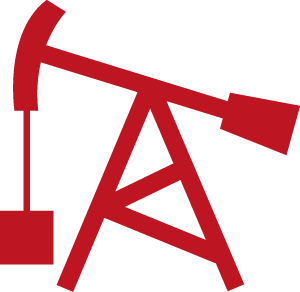Our eco-friendly approach
Documentation
Our 4 main focus areas
I-Earning labels and certifications
II-Using the environmental footprint eco-calculator
III-Using more flame retardant recycled polyester yarn in our products
IV-Maintaining French textile expertise
The main objective is to reduce our environmental impact by reviewing all of our manufacturing processes.
Our global commitment :
Help reduce the environmental impacts of our production while complying with current flame retardant standards for the public buildings market.
Public buildings
I- Labels and certifications
We focused on the following labels to guide and certify our CSR initiative :

France Terre Textile
France terre textile®: this certification guarantees for all stakeholders (consumers, distributors, business users, etc.) that at least 75% of the steps in producing the certified item were completed in historical French textile industry centres. It also certifies compliance with quality and environmental standards specific to French textile production. It brings the sector together to support a dynamic approach that promotes and maintains French expertise.
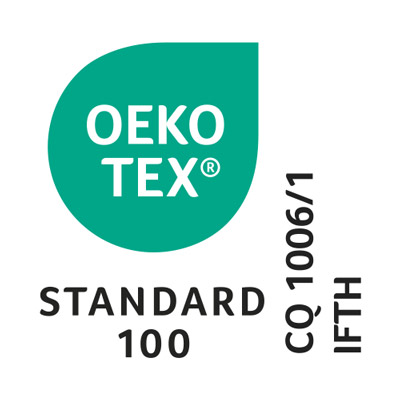
OEKO-TEX® STANDARD 100 (n° de certificat CQ 1006/1 IFTH)
OEKO-TEX® STANDARD 100 (certificate no. CQ 1006/1 IFTH): this certification ensures that products do not contain chemical products or products that may be harmful to health. This guarantees that a product with the STANDARD 100 certification has been reliably tested for harmful substances by neutral test institutes based on a catalogue of scientific criteria.
Good to know: The OEKO-TEX® brand identity changed in 2022. The commitment is exactly the same. The new logo will progressively replace the old one on our sample boards as they are updated. To be valid, the “OEKO-TEX certified” note is only applicable to products and not to an entire company. A company sells OEKO-TEX certified products based on the class indicated on its certificate (for example, polyester fabric, FR polyester, etc.). This note must also be followed by the certificate number and the certifying body (in Sotexpro’s case: CQ 1006/1 IFTH). These items enable a customer to verify the information directly with OEKO-TEX.
In addition, here is some important information about our production :
Local weaving
We give preference to and value local partners whose expertise guarantees a high level of quality.
Textile printing
Sublimation printing uses water-based, solvent-free inks.
Dyeing
Our production waste is sorted, compacted and reused (for example, polyester scraps are broken down and transformed into stuffing).
Waste sorting
We use the exhaust bath method to dye polyester. This technique requires less water and releases fewer colourants than dyes on natural materials.
II- Environmental footprint eco-calculator: a sotexpro innovation
This is a true innovation in our method of communicating with and guiding our clients. Until now, there was nothing that provided transparency and a clear picture about the environmental impact of our products.
This is what sparked the idea to develop: THE ENVIRONMENTAL FOOTPRINT ECO-CALCULATOR.
For this initiative, our R&D team and our CSR project manager were supported by an LCA (life cycle assessment) consultant as they developed this project that enables us to anticipate future requirements on environmental disclosure regulated by the AGEC law whose objective is to better inform consumers about product environmental qualities and characteristics.
As a reminder: Decree No. 2022-748 of April 29, 2022, implementing Article 13 I of the AGEC law, now provides a framework for environmental claims by sellers and makes it mandatory to inform consumers about certain environmental characteristics of purchased products.
We followed directives stipulated by the ISO 14040-44 and BP X 30-323-24 standards to develop our calculator. This means we collected as much specific (primary) data from our suppliers and rounded it out with secondary data from the ADEME (Agence de l’environnement et de la maîtrise de l’énergie) Base Impact database. This approach enabled us to quantify all of the necessary information for calculating environmental impacts for the entire life cycle of our products. This data was then integrated into our calculator to generate scores for the entire life cycle and each stage for every product.
This tool enables us to generate three key indicators suitable for the textile industry using measurements taken from the entire life cycle :
Carbon footprint
Carbon footprint
Amount of greenhouse gas (GHG) emitted over the entire product life cycle, which causes climate change.
Shown in kilograms of CO2 equivalent, as well as in number of kilometres driven in a car.
Water consumption
Water consumption
Amount of fresh water consumed over the entire product life cycle. Shown in m3, as well as in number of showers.
Fossil fuel consumption
Fossil fuel consumption
Amount of primary fossil fuel (oil) used over the entire product life cycle. Shown in MJ (megajoule), as well as in number of smartphone charges. Shown as a percentage of total finished product. These calculations are expressed in m2 (functional unit designated by UF); for example, Kg of CO2 emitted per 1 m2 of fabric.
III- How are these indicators shared?
The results are shared on detailed eco-profile sheets that highlight all of these indicators by life cycle stage and summarised in a comparative table. Contact your adviser to request these documents.
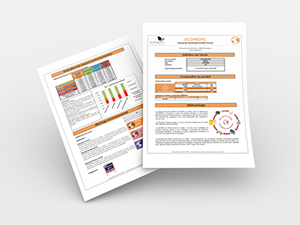
For even more representative results, we can use our calculator to output results for an entire past or forecasted order:
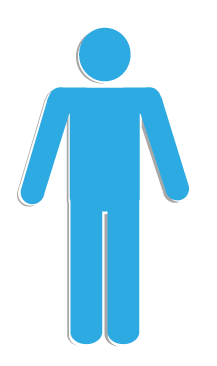
I’m hesitating between the NOCHE and NOCTURNE products.
Their environmental impact will influence my choice
What would you suggest?
COMPARISON TOOL
Compared to NOCTURNE, using NOCHE can save the equivalent per m² of:


kg of CO2
the pollution of a
6,6 km trip by car
MJ
77
smartphone charges

kg of CO2
the pollution of a
6,6 km trip by car

MJ
77
smartphone charges
ENTIRE ORDER
For an order of: 1100 m²
Compared to NOCTURNE, using NOCHE for this order can save the equivalent of:


kg of CO2
the pollution of a
7260 km trip by car
MJ
85140 smartphone charges

kg of CO2
the pollution of a
7260 km trip by car

MJ
the energy used for
85140 smartphone charges
*The France terre textile® certification guarantees for all stakeholders (consumers, distributors, business users, etc.) that at least 75% of the steps in producing the certified item were carried out in historical French textile industry centres.
IV- Maintaining french textile expertise: responsible purchasing and the value of local partners for sustainable and virtuous services
Sotexpro is aware of the role we can play in developing and sustaining French expertise, so we have always chosen and valued partnerships with local weavers, dyers and finishers.
Our R&D and creative teams work collaboratively with companies who have exceptional expertise to develop products with high added value for the technical, aesthetic and ecological aspects.
This initiative is particularly visible with the “expertise and personalisation” service that enables our clients to develop their projects and creates a direct link between them and this expertise.
The “petit book” personalisation brochure
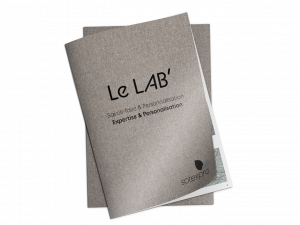
With a stable balance of power, Sotexpro has developed close connections with different stakeholders in our value chain by putting some of our own weaving looms directly in partner facilities. Sotexpro is also available to assist them with their environmental transition, thereby contributing to sustainable production.
The expertise, versatility and flexibility of our partners guarantee a high level of quality. This regional base helps protect traditional expertise, enables more environmentally friendly production and supports local manufacturing jobs.
Do you have a project?
Our sales staff can provide you with support and in-depth expertise on standards for specific types of establishment (schools, hotels, retirement homes, healthcare, etc.).
